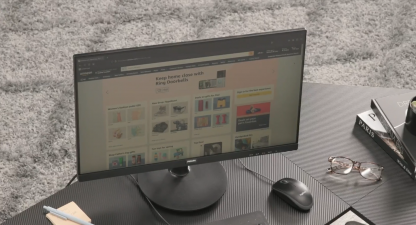Definitive Guide: Philips Full HD 100 Hz Monitors for Gaming, Office, and Entertainment
Choosing the right monitor can transform your gaming, work, or streaming experience. Today, we dive into the Philips Full HD 100 Hz lineup—a budget-friendly option that balances smoothness, sharpness, and affordability. We’ll cover their strengths, IPS vs. VA nuances, usage recommendations, and tips to get the most out of them.
1. Why 100 Hz Matters
Most standard monitors run at 60 Hz (60 frames per second). Jumping to 100 Hz gives you:
- Smoother motion: panning in games or scrolling long documents feels more fluid.
- Reduced motion blur: fast-moving objects stay crisp.
- Better responsiveness: in competitive shooters or MOBAs, extra frames can sharpen your aim and reaction time.
In short: if you play fast-paced games—or simply scroll through webpages—a 100 Hz display feels noticeably closer to real life.
2. Philips 100 Hz Models at a Glance
Philips offers several options in this category. Here are three standout picks:
2.1 Philips 27E1N1100D/27
- Screen Size: 27″ IPS LED
- Resolution: Full HD (1920 × 1080)
- Refresh Rate: 100 Hz
- Response Time: 1 ms (MPRT)
- Viewing Angles: 178°/178°
- Best For: Gamers seeking vibrant colors and wide viewing angles, plus designers needing accurate color representation.
2.2 Philips 24E2N1100LB/00
- Screen Size: 23.8″ VA LED
- Resolution: Full HD (1920 × 1080)
- Refresh Rate: 100 Hz
- SmartContrast: Deeper blacks
- Viewing Angles: 176°/176°
- Best For: Movie buffs and multimedia tasks with dark scenes, thanks to its high contrast ratio.
2.3 Philips 241V8LB
- Screen Size: 23.8″ VA LED “frameless”
- Resolution: Full HD (1920 × 1080)
- Refresh Rate: 100 Hz
- Ports: HDMI 1.4 × 1, VGA × 1
- Extras: 4-year advanced-replacement warranty, Eye Care and EasyRead modes
- Best For: Multi-monitor setups (thanks to minimal bezels) and long reading sessions without eye strain.
3. IPS vs. VA: Which Panel Is Right for You?
| Feature | IPS | VA |
|---|---|---|
| Contrast | ~1,000:1 (Medium) | ~3,000–5,000:1 (High) |
| Viewing Angles | 178°/178° (Uniform) | 176°/176° (Slightly narrower) |
| Color Accuracy | Excellent (Consistent RGB) | Good (Possible variation in grays/blacks) |
| Response Time | 1 ms MPRT in some models | 1 ms MPRT or 4 ms GtG |
| Recommended For | Graphic design, photography, competitive gaming | Movies, series, casual gaming |
- IPS delivers precise colors and wide viewing angles.
- VA shines in contrast, offering deeper blacks for dark content.
4. Ergonomics & Connectivity
Despite their budget price, Philips monitors pack useful comfort features:
- VESA Mount (100 × 100 mm): Attach to monitor arms or wall brackets.
- Tilt Adjustment: Typically –5° to 20°, enough for most desk setups.
- Cable Management: Integrated channels in the stand keep your desk tidy.
- Inputs: Usually HDMI and VGA—verify if you need DisplayPort or multiple HDMI ports.
5. Eye Care Technologies
Long sessions can strain your eyes. Philips includes:
- LowBlue Mode: Filters harmful blue light.
- Flicker-Free: Eliminates invisible flicker to reduce fatigue.
- EasyRead (selected models): Simulates paper-like reading comfort for e-books and documents.
Activate these features via the OSD menu, often through the EasySelect hotkey on the bezel.
6. Tips to Maximize Your Philips 100 Hz
- Enable 100 Hz in Windows
Settings > System > Display > Advanced display settings > Refresh rate. - Calibrate Colors
Use Windows’ built-in calibration or tools like Datacolor Spyder. - Update GPU Drivers
Ensure compatibility with high-frame-rate profiles. - Use a Quality Cable
HDMI 1.4 minimum for 1080p@100 Hz; DisplayPort if supported. - Adjust Contrast & Brightness
Match ambient lighting to reduce eye strain and save energy.
7. Pros & Cons
- Highly competitive pricing versus 144 Hz alternatives.
- Strong balance of fluidity and visual quality.
- Low response times (1 ms MPRT).
- Comprehensive eye-care features.
- Full HD resolution on larger (27″) screens can limit sharpness.
- Basic ergonomics (most models lack height adjustment).
- Simple connectivity—double-check ports if you need DP or multiple inputs.
8. Who Should Buy One?
- Gamers upgrading from 60 Hz without the 144 Hz price tag.
- Office professionals who value flicker-free panels and easy reading.
- Multimedia enthusiasts preferring deep contrast and vibrant visuals.
- Multi-monitor builders benefiting from frameless designs.
9. Conclusion
Philips Full HD 100 Hz monitors strike an intelligent middle ground: buttery-smooth motion and solid image quality at an accessible cost. You won’t sacrifice much in color or performance, and your eyes will thank you during extended sessions.


